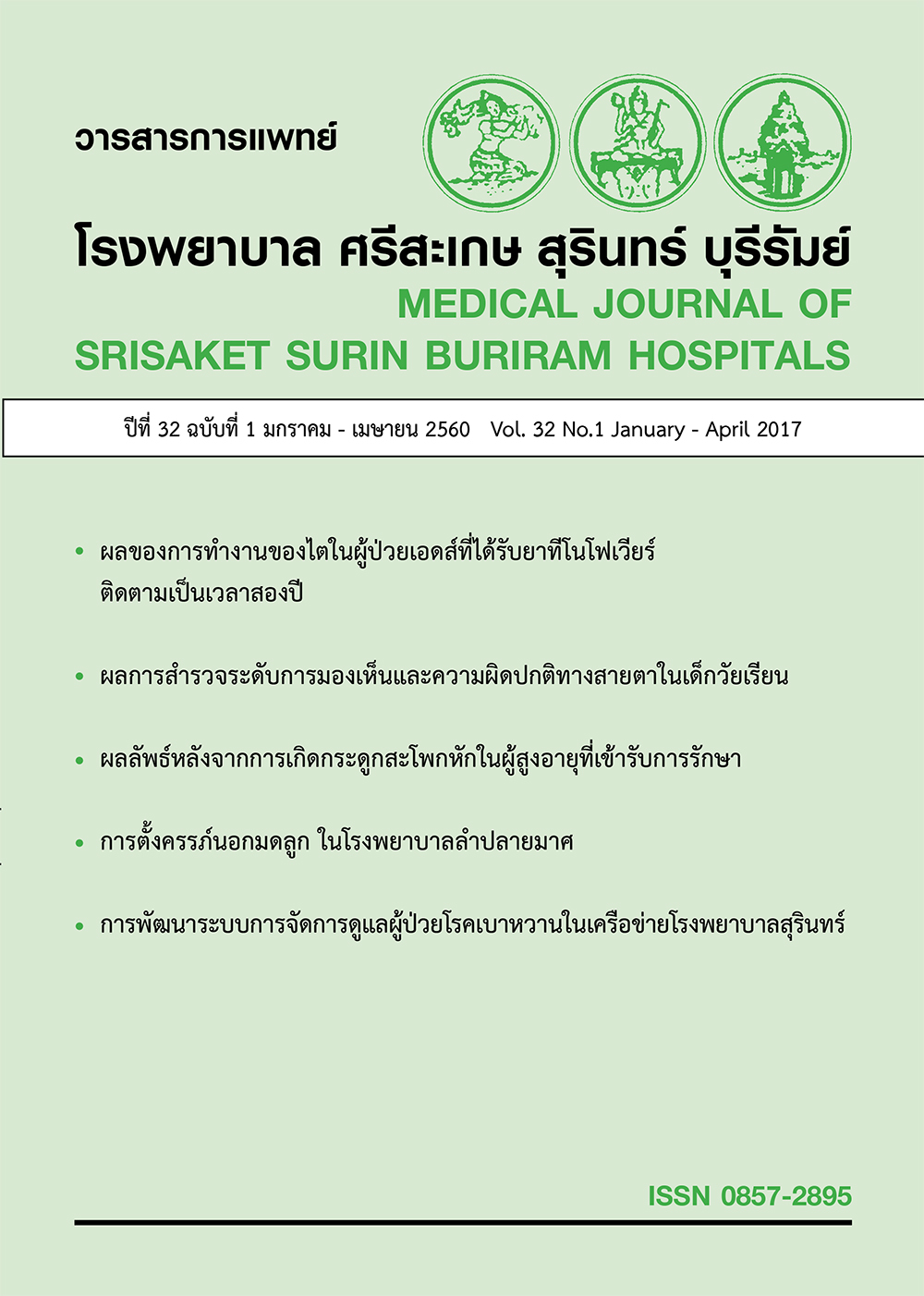ผลของการทำงานของไตในผู้ป่วยเอดส์ที่ได้รับยาทีโนโฟเวียร์ ติดตามเป็นเวลาสองปี
Main Article Content
บทคัดย่อ
หลักการและเหตุผล: ยาต้านไวรัสเอชไอวี tenofovir disoproxil fumarate (TDF) เป็นยาหลักที่ อยู่ในสูตรสำหรับผู้ป่วยติดเชื้อไวรัสเอชไอวีและเอดส์ แต่ยา TDF มีผลข้างเคียงต่อการทำงานของไต ปัจจุบันในประเทศไทยยังไม่มีการศึกษาติดตามการทำงานของไตจากการใช้ยา TDFในระยะเวลาสองปี การศึกษานี้มีวัตถุประสงค์ เพื่อศึกษาอุบัติการณ์ผู้ป่วยที่รับยา TDF และมีการทำงานของไตลดลงตั้งแต่ร้อยละ 25 หลังได้รับยา TDF เป็นเวลาสองปีและศึกษาปัจจัยที่ส่งผลต่อการลดลงของการทำงานของไต
วิธีการศึกษา: เป็นการศึกษาย้อนหลังในผู้ป่วยติดเชื้อไวรัสเอชไอวีและเอดส์ที่ได้รับยา TDF ในคลินิกภูมิคุ้มกันบกพร่องโรงพยาบาลสุรินทร์ ตั้งแต่เดือนมกราคม พ.ศ. 2553 ถึงเดือนธันวาคม พ.ศ. 2555 เพื่อประเมินอัตราการกรองของไตคำนวณด้วยสูตร modification of diet in renal disease (MDRD) โดยประเมินที่ก่อนเริ่มยาและสองปีและศึกษาข้อมูลทั่วไป ประวัติการรักษา และปัจจัยที่เกี่ยวข้อง
ผลการศึกษา: มีผู้ป่วยทั้งหมด 135 รายที่ได้รับยา TDF เป็นเวลา 2 ปี เป็นเพศหญิง 74 ราย (ร้อยละ 54.8 ) มีอายุเฉลี่ย 39.7 8.5 ปี และมีมัธยฐานของจำนวนซีดีสี่เริ่มต้นเท่ากับ 274 เซลล์ต่อมิลลิลิตร (IQR 133-432 cell/mm3) ผลการศึกษา พบว่ามีการทำงานของไตลดลงจากเดิมก่อนเริ่มยาตั้งแต่ร้อยละ 25 จากการคำนวณโดยใช้สูตร MDRD formula ทั้งหมด 26 ราย คิดเป็นร้อยละ 19.3 และเมื่อแบ่งผู้ป่วยออกเป็น 2 กลุ่ม คือกลุ่มที่มีอัตราการทำงานของไตลดลงจากเดิมก่อนเริ่มยา TDF ตั้งแต่ร้อยละ 25 และกลุ่มที่มีอัตราการทำงานของไตลดลงจากเดิมไม่ถึงร้อยละ 25 พบว่า การมีภาวะ lipodystrophy เป็นปัจจัยที่มีผลต่ออัตราการทำงานของไตที่ลดลง (adjusted odds ratio, 2.16; 95% Cl, 0.66 to 7.01) ส่วนการมีภาวะซีดจากยา AZT (adjusted odds ratio, 0.45; 95% Cl, 0.10 to 2.20) และการมีค่า BMI เพิ่มขึ้น 1 kg/m2 (adjusted odds ratio, 0.84; 95% Cl, 0.70 to 1.02) เป็นปัจจัยที่ช่วยชะลอการเกิดอัตราการทำงานของไตลดลง อย่างไรก็ตามปัจจัยเหล่านี้ไม่พบว่ามีความสำคัญทางสถิติ ทั้งนี้ ไม่พบผู้ป่วยที่ต้องหยุดยา TDF ระหว่างการศึกษาหรือมีการเปลี่ยนแปลงทางคลินิกของผู้ป่วย
สรุป: ที่ระยะเวลา 2 ปีหลังจากใช้ยา TDF ในผู้ป่วยติดเชื้อเอชไอวีและเอดส์พบอัตราการกรองของไตลดลงกว่าตั้งแต่ร้อยละ 25 จำนวน 26 ราย (ร้อยละ 19.3) แต่ไม่มีการเปลี่ยนแปลงทางคลินิกของผู้ป่วยและยังคงต้องการการศึกษาที่ เฝ้าติดตามผู้ป่วยในระยะเวลานานขึ้น มีจำนวนประชากรเพิ่มขึ้น และมีกลุ่มควบคุมต่อไปในอนาคต
Article Details
References
2. ประพันธ์ ภานุภาค, ทวีทรัพย์ ศิรประภาศิร, วสันต์ จันทราทิตย์, วิชัย เตชะสาธิต,อัจฉรา ธีรรัตน์กุล, กุลกัญญา โชคไพบูลย์กิจ, สมนึก สังฆานุภาพ. แนวทางการตรวจวินิจฉัยและการดูแลรักษาผู้ติดเชื้อเอชไอวีและผู้ป่วยเอดส์ ระดับชาติ ปี พ.ศ. 2553. กรุงเทพฯ : ชุมนุมสหกรณ์การเกษตรแห่งประเทศไทย จำกัด: ศูนย์พัฒนาระบบบริการยาต้านไวรัส สำหรับผู้ติดเชื้อเอชไอวี และผู้ป่วยเอดส์ในประเทศไทย; 2553.
3. Zimmermann AE, Pizzoferrato T, Bedford J, Morris A, Hoffman R, Braden G. Tenofovir-associated acute and chronic kidney disease: a case of multiple drug interactions. Clin Infect Dis 2006;42(2):283-90. Epub 2005/12/16.
4. Verhelst D, Monge M, Meynard JL, Fouqueray B, Mougenot B, Girard PM, et al. Fanconi syndrome and renal failure induced by tenofovir: a first case report. Am J Kidney Dis 2002;40(6):1331-3. Epub 2002/12/03.
5. Karras A, Lafaurie M, Furco A, Bourgarit A, Droz D, Sereni D, et al. Tenofovir-related nephrotoxicity in human immunodeficiency virus-infected patients: three cases of renal failure, Fanconi syndrome, and nephrogenic diabetes insipidus. Clin Infect Dis 2003;36(8):1070-3. Epub 2003/04/10.
6. Coca S, Perazella MA. Rapid communication: acute renal failure associated with tenofovir: evidence of drug-induced nephrotoxicity. Am J Med Sci 2002;324(6):342-4. Epub 2002/12/24.
7. Creput C, Gonzalez-Canali G, Hill G, Piketty c, Kazatchkine M, Nochy D. Renal lesions in HIV-l-positive patient treated with tenofovir. AIDS 2003;17(6):935-7. Epub 2003/03/28.
8. Perazella MA. Drug-induced renal failure: update on new medications and unique mechanisms of nephrotoxicity. Am J Med Sci 2003;325(6):349- 62. Epub 2003/06/18.
9. Izzedine H, Hulot JS, Vittecoq D, Gallant JE, Staszewski S, Launay-Vacher V, et al. Long-term renal safety of tenofovir disoproxil fumarate in antiretroviral-naive HIV-1-infected patients. Data from a double-blind randomized active-controlled multicentre study. Nephrol Dial Transplant 2005;20(4):743-6. Epub 2005/03/03.
10. Izzedine H, Launay-Vacher V, Deray G. Antiviral drug-induced nephrotoxicity. Am J Kidney Dis 2005;45(5):804-17. Epub 2005/04/30.
11. Pierrat A, Gravier E, Saunders C, Caira MV, Ait-Djafer Z, Legras B, et al. Predicting GFR in children and adults: a comparison of the Cockcroft-Gault, Schwartz, and modification of diet in renal disease formulas. Kidney Int 2003;64(4): 1425-36. Epub 2003/09/13.
12. Szczech LA. Renal dysfunction and tenofovir toxicity in HIV-infected patients. Topics in HIV medicine : a publication of the International AIDS Society, USA. 2008;16(4):122-6.
13. Gallant JE, Parish MA, KerulyJ C, Moore RD. Changes in renal function associated with tenofovir disoproxil fumarate treatment, compared with nucleoside reverse-transcriptase inhibitor treatment. Clin Infect Dis 2005;40(8):1194-8. Epub 2005/03/26.
14. Kiertiburanakul S, Chaisiri K, Kasettratat N, Visuttimak P, Bowonwatanuwong C. Monitoring of Renal Function among HIV-Infected Patients Receiving Tenofovir in a Resource-Limited Setting. J Int Assoc Physicians AIDS Care 2011;10(5):297-302.
15. Nelson MR, Katlama C, Montaner JS, Cooper DA, Gazzard B, Clotet B, et al. The safety of tenofovir disoproxil fumarate for the treatment of HIV infection in adults: the first 4 years. AIDS 2007 Jun 19;21(10):1273-81.
16. Manosuthi W, Mankatitham W, Lueangniyomkul A, Prasithsirikul W, Tantanathip P, Suntisuklappon B, et al. Renal impairment after switching from stavudine/lamivudine to tenofovir/lamivudine in NNRTI-based antiretroviral regimens. AIDS Res Ther 2010;7(1):37.

